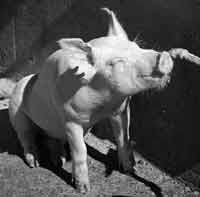Mixup faulted in pigs' death
By RYAN SMITH
What was first thought to be an accident, the death of a group of pigs
at the university farm Sunday morning, apparently resulted from a series
of unforeseen problems and miscommunication.
| 
Joseph Hollak/The Collegian
The death of 72 pigs at the university farm was the result of miscommunication
among agriculture units. |
A campus power outage turned one of the only fully ventilated buildings
at the farm into a furnace, trapping about 90 pigs, 69 of which died from
hyperthermia—and three others died from exposure.
When the power shut off, the ventilation system failed to operate and,
as a result, air and temperature regulation inside the room could not
be controlled. In just a few short hours, the body temperatures of the
pigs heated up the room to a life-threatening degree.
The dead pigs were not discovered until later that morning when students
arrived at the swine unit to start feeding the animals.
A student working at the dairy unit Sunday morning around 2 a.m. was the
first person to report the power outage.
The student was milking cows when the power went out and she called the
student herdsman, Eric McDaniel, who came out and turned on their backup
generator. The dairy relies on electricity to help run the milking pumps,
but the two farm units don’t run on the same generator.
The problem, said a student manager at the swine unit who asked to remain
unnamed, occurred because of the dairy’s failure to inform someone
from the swine unit that the power had gone off.
“He (McDaniel) powered the dairy up and forgot about us. We are
the only ones that have animals in a completely ventilated area,”
said the student manager.
He said McDaniel knew nothing about livestock and that McDaniel had told
the manager that he thought the pigs would be OK.
“He made a poor judgment and he should have called us,” said
the manager. “I’ve been called out here for a loose pig at
one o’clock in the morning, and we don’t get a phone call
for the power outage?”
McDaniel confirmed that he had received a phone call Sunday morning to
come out and get the generator running but said it hadn’t occurred
to him to call someone from the swine unit.
“My main concern was here (at the dairy),” McDaniel said.
“My job is to take care of this place.
“We need to milk the cows on time and if we don’t, they can
get sick.”
Carl Pherson, director of agricultural operations, said every unit at
the farm has an emergency contact list containing phone numbers of people
from all the other units. Pherson also suggested it would have been a
good idea if someone from the dairy had notified personnel from the swine
unit upon learning of the outage.
“I described this as the perfect storm,” Pherson said. “We
may think that we have everything in order and then our first line of
defense, communication, didn’t work.
“We thought we had enough in place—it’s worked for 50
years—and this time it didn’t work and we suffered a loss.”
Another problem that could have led to the death of the pigs, Pherson
said, was the absence of an alarm in the room to signal a power outage.
Pherson said the farrowing building, which he described as being like
a maternity room, has a high-temperature sensor alarm that will go off
if the temperature gets too high. But, if the power goes out, the sensor
will not work.
Pherson said that as a result of the deaths, the school will be installing
an alarm system in the room and will look into upgrading the temperature
sensor at the farrowing building. Some of the options they are looking
into are an alarm system powered through the phone lines and a system
powered by an uninterrupted power source—which Pherson said could
cost considerably more.
“We have a 50-plus year record of taking care of these critters,
and it’s disconcerting to see this happen,” Pherson said.
The death of the pigs is estimated to be around $3,000. The figure relates
to how much it will cost to replace the lost pigs with pigs of the same
age. However, estimated losses in revenue that the school could have made
once the pigs got older and bigger are around $10,500, Pherson said.
“The first use of the pigs is for instruction,” Pherson said.
“Any revenue by selling pigs is reinvested into the program to buy
new animals, to buy food and to purchase equipment.”
Sharing Pherson’s concern for the pigs was the swine unit’s
manager.
“It isn’t about the money we lost, but it’s more about
the way they suffered,” the manager said. “The well-being
of the animal is my biggest concern. If you’ve never seen an animal
die of heat—it’s a terrible sight.
“This will be a big loss to the program and it will hurt us.”
|

